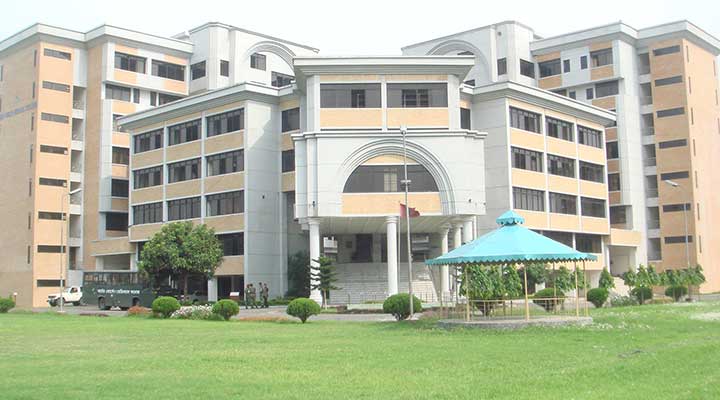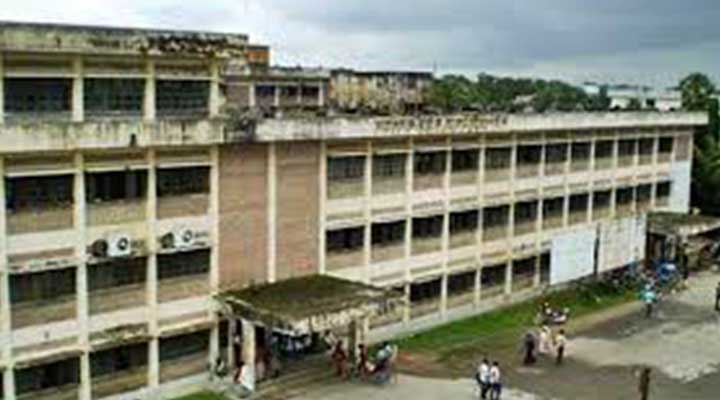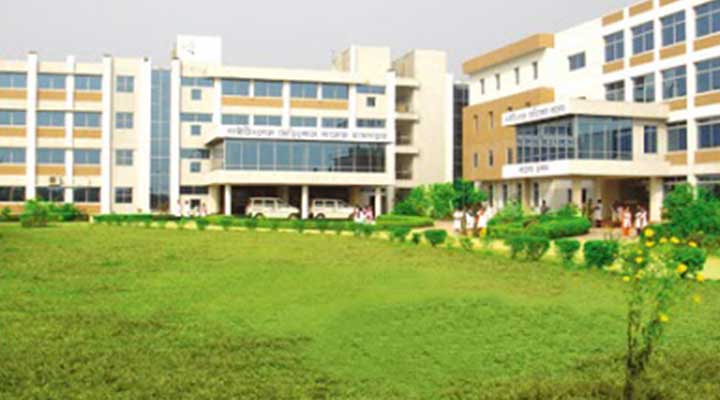Study MBBS in Bangladesh
The complete duration of an MBBS program in Ukraine is 5.8 years. The students are not required to pass any entrance examination to get admission in a medical university in Ukraine.
Bangladesh was a part of India so it has almost all benefits of studying
in India. Many Indian & Nepali students are already studying in Bangladesh
for last many years. Advantages of studying MBBS in Bangladesh are mentioned
below:
- 5 Year’s Course, Internship in
Bangladesh is valid in India (not for other countries)
- Bangladesh is almost same as India (same language, weather, culture, Bacteria & disease
pattern & medical practice)
- Best clinical exposure (due to high population) with highest FMGE/MCI Test Result (other students are
struggling)
- MCI (Medical
Council of India), WHO (World
Health Organization), BM&DC (Bangladesh
Medical & Dental Council) Listed
& Approved Colleges, Affiliated to Very Old & Renowned Universities
- Syllabus is same as India, No Language Classes
& Exams (all other countries has separate language classes
& exams)
- Quality Education for Quality Students (Students who have passed 12th in current
year or last year only they are eligible for admissions with minimum 60%
in Bio and overall also 60% required in 10th & 12th Class)
(most of the other countries are taking any students who is paying money)
- Lowest Travelling Cost & No Local
Transportation Cost as Hospital, Hostel and Campus are within
same premises
- No need of Indian Canteen, Care Taker and
MCI Coaching makes Bangladesh best option for Indian Students
- Bangladesh is world’s
3rd largest country with Hindu Population after
India & Nepal.
- Bangladesh and India has very strong diplomatic, political and cultural.
Yes, Bangladesh is one of the best options for
Indian Students, it’s logical and simple. Reasons are listed below:
Weather–
If you opt for Bangladesh you don’t need to face extreme cold weather (Russia,
Ukraine, Belarus, Kazakhstan, Kyrgyzstan, Tajikistan, Georgia and China all
countries has 2 to 6 months extreme cold weather, -5 to -45 degree), this helps
students in Bangladesh to focus on studies, they get more time to study and a
right environment to study.
Language – Students in
Bangladesh do not need to attend classes for language, mother tongue is
Bangladesh is Bengali and if anyone is comfortable in Hindi, they can speak
Bengali in 2-3 months because most of words are similar to Hindi. In case of
other countries student need to attend separate classes for local language
(Russian, Ukrainian, Kazakh, Kirgiz, Tajikistani, Chinese, Georgian or other
language), they also need to pass exam for local language, which is time and
effort taking process. If you study in Bangladesh you get more time to study
medical subjects.
Food – Bangladesh
is separated from India, so eating habits and similar to India. You will get
Samosa, Jalebi, Tea, Milk, Coffee, and Parantha in breakfast. You will get
Roti, Vegetable, Dal, Rice and other similar dishes in Bangladesh. Most of the
institutes in Bangladesh has canteen within campus where students can get
vegetarian and non vegetarian food at subsidized cost. If you compare with
other countries, eating habits are different so students don’t get food of
their choice and they spend additional money exploring more options, this
results in increased cost of food still students are left unsatisfied for food.
Bactria, Disease Pattern and treatment – as weather and eating habits are similar to India, which
results in same Bactria, disease pattern and same treatment which you observe
in India. If you opt for Bangladesh you study and do clinical rotation in with
same Bactria, disease patter and follow the same treatment which is observed
and followed in India, so you have better chance to clear MCI Screening test as
it is based on medical conditions and cases found in India. If you compare with
cold countries, there are few differences in Bactria and disease pattern also,
which results different treatment and methodology for practice medicine.
Syllabus and Books – Syllabus and
Books are same as India. Even most of the students use books and charts of
Indian authors. This is very helpful for Indian students, because it becomes
easy to understand the language and methodology they use to explain medical
education. Other countries have different books and methodology for teaching
and pattern is also different.
Hospital and Hostel Facilities – All colleges in Bangladesh has separate Hostel
facilities for boys & girls, multi speciality hospitals within campus,
which results in better clinical exposure. In case of other countries they have
a concept of associated hospital, where students from multiple
institutes/university go for practice/clinical. If you study in some other
country you don’t have enough opportunity get good clinical exposure.
Travelling from hostel to campus and campus to hospital also cause waste of
time and money.
Other Benefits & Expenses – cost and time of travel is lowest if you travel from
your home town. You can travel by bus, train and flight. Cost of travel is also
less. If you calculate cost of return ticket Bangladesh will cost 10,000 to
20000 rupees (flight), if you compare with other countries it will cost approx
40,000 to 60,000 rupees. In case of Bangladesh you can also travel by bus,
which cost 5000 to 8000 rupees for return ticket, this cannot be compared with
any other country. This minimizes your total cost of education. Pocket money is
also less required as you don’t need to travel more as Hospital, Campus and
Hostel are in the same premises. You get food similar to India so you don’t
need to spend more of exploring options. These all are additional advantages of
studying in Bangladesh.
Best MCI Screening Test Pass Rate – now I don’t think I need to justify this, if culture,
weather, language, eating habits, syllabus, books, Bactria and disease pattern
are same as India, so chance of passing MCI Screening Test/FMGE/NEET PG is
always higher than any other country in the world.
Students with good academics are admitted for MBBS in Bangladesh, so if your academics are good if you have
completed 12th in current year or last year, you become eligible for Bangladesh
and I
can assure you will not find any old student (dropper) or students below 65/70%
in 12th class. This justifies the quality of students and
also the quality of education. If you compare with other countries most of the
countries allow students with pass class (40%), some of them allow anything
above 50%, most of the countries allow students with gap of 1/2/3/4/5 years.
That affects difference in age, grasping power, speed of learning of entire
class and environment of studies.
LIST OF COLLEGES IN BANGLADESH FOR MBBS ADMISSION
Know about the colleges in Bangladesh listed with BMDC (Bangladesh Medical & Dental Council), Government of Bangladesh, Listed with MCI (Medical Council of India), (NMC) Nepal Medical Council and WHO (World Health Organization) Directory.
- Govt – Armed Forces Medical College – Bangladesh University of Professionals (BUP)
- Private – B.G.C Trust Medical College – Chittagong University (U. Ctg.)
- Private – Mainamoti Medical College – Chittagong University (U. Ctg.)
- Private – Southern Medical College & Hospital (Recognition withheld) – Chittagong University (U.Ctg)
- Govt – Abdul MalekUkil Medical College – Chittagong University (U.Ctg.)
- Private – Central Medical College, Comilla – Chittagong University (U.Ctg.)
- Private – Chattagram Maa-O-Shishu Hospital Medical College – Chittagong University (U.Ctg.)
- Govt – Chittagong Medical College – Chittagong University (U.Ctg.)
- Govt – Comilla Medical College – Chittagong University (U.Ctg.)
- Govt – Cox’s Bazar Medical College – Chittagong University (U.Ctg.)
- Private – Eastern Medical College, Comilla – Chittagong University (U.Ctg.)
- Private – Bangladesh Medical College – Dhaka University (U. Dhaka)
- Private – Community Based Medical College – Dhaka University (U. Dhaka)
- Private – Delta Medical College – Dhaka University (U. Dhaka)
- Govt – Dhaka Medical College – Dhaka University (U. Dhaka)
- Private – Dhaka National Medical College – Dhaka University (U. Dhaka)
- Private – East West Medical College – Dhaka University (U. Dhaka)
- Private – Enam Medical College – Dhaka University (U. Dhaka)
- Govt – Faridpur Medical College – Dhaka University (U. Dhaka)
- Private – Holy Family Red Crescent Medical College – Dhaka University (U. Dhaka)
- Private – Ibrahim Medical College – Dhaka University (U. Dhaka)
- Private – International Medical College – Dhaka University (U. Dhaka)
- Private – Jahurul Islam Medical College – Dhaka University (U. Dhaka)
- Private – Kumudini Women’s Medical College – Dhaka University (U. Dhaka)
- Private – M.H. Samorita Hospital and Medical College – Dhaka University (U. Dhaka)
- Private – Medical College for Women & Hospital – Dhaka University (U. Dhaka)
- Govt – Mymensingh Medical College – Dhaka University (U. Dhaka)
- Private – Shahabuddin Medical College – Dhaka University (U. Dhaka)
- Private – ShaheedMonsur Ali Medical College – Dhaka University (U. Dhaka)
- Govt – ShaheedSuhrawardi Medical College – Dhaka University (U. Dhaka)
- Govt – Shaheed Syed Nazrul Islam Medical College – Dhaka University (U. Dhaka)
- Govt – Sher-E-Bangla Medical College – Dhaka University (U. Dhaka)
- Govt – Sir Salimullah Medical College – Dhaka University (U. Dhaka)
- Private – Tayerunnessa Memorial Medical College – Dhaka University (U. Dhaka)
- Private – UttaraAdhunik Medical College – Dhaka University (U. Dhaka)
- Private – Z. H. SikderWomens Medical College – Dhaka University (U. Dhaka)
- Private – Ad-din Women’s Medical College – Dhaka University (U.Dhaka)
- Private – Anwar Khan Modern Medical College – Dhaka University (U.Dhaka)
- Private – City Medical College (Recognition withheld) – Dhaka University (U.Dhaka)
- Private – Dhaka Central International Medical College & Hospital – Dhaka University (U.Dhaka)
- Private – Dhaka Community Medical College – Dhaka University (U.Dhaka)
- Private – Diabetic Association Medical College – Dhaka University (U.Dhaka)
- Private – Dr. Sirajul Islam Medical College Hospital – Dhaka University (U.Dhaka)
- Private – Green Life Medical College – Dhaka University (U.Dhaka)
- Private – Marks Medical College – Dhaka University (U.Dhaka)
- Private – Monno Medical College – Dhaka University (U.Dhaka)
- Private – Northern International Medical College Hospital – Dhaka University (U.Dhaka)
- Private – Popular Medical College – Dhaka University (U.Dhaka)
- Private – IbnSina Medical College – Dhaka University(U. Dhaka)
- Private – Nightingale Medical College (Recognition withheld) – Dhaka University(U. Dhaka)
- Private – SamajVittik Medical College – GonoBishwabiddalay (G.B.)
- Private – Ad-dinSakina Medical College – Rajshahi University (U. Raj.)
- Govt – Dinajpur Medical College – Rajshahi University (U. Raj.)
- Private – Islami Bank Medical College – Rajshahi University (U. Raj.)
- Govt – Jessosre Islam Medical College – Rajshahi University (U. Raj.)
- Govt – Khulna Medical College – Rajshahi University (U. Raj.)
- Private – KhwajaYunus Ali Medical College – Rajshahi University (U. Raj.)
- Private – North Bengal Medical College – Rajshahi University (U. Raj.)
- Govt – Pabna Medical College – Rajshahi University (U. Raj.)
- Govt – Rajshahi Medical College – Rajshahi University (U. Raj.)
- Govt – Rangpur Medical College – Rajshahi University (U. Raj.)
- Govt – ShaheedZaiurRahman Medical College, – Rajshahi University (U. Raj.)
- Private – Barind Medical College – Rajshahi University (U.Raj.)
- Private – Gazi Medical College – Rajshahi University (U.Raj.)
- Private – Northern (Pvt.) Medical College (Recognition withheld) – Rajshahi University (U.Raj.)
- Private – Prime Medical College – RajshahiUniversity(U. Raj.)
- Private – Rangpur Community Medical College – RajshahiUniversity(U. Raj.)
- Private – T.M.S.S. Medical College – RajshahiUniversity(U. Raj.)
- Private – Jalalabad RagibRabeya Medical College – Shahjahal University of Science & Technology (SUST)
- Govt – M.A.G. Osmani Medical College – Shahjahal University of Science & Technology (SUST)
- Private – North East Medical College – Shahjahal University of Science & Technology (SUST)
- Govt – Sylhet M.A.G. Osmani Medical College – Shahjahal University of Science & Technology (SUST)
- Private – SylhetWomens Medical College – Shahjahal University of Science & Technology (SUST)
- Private – Parkview Medical College – Shahjalal University of Science & Technology (SUST)
- Private – Institute of Applied Health Science (IAHS) – University of Science & Technology, Chittagong (U.S.T.C.)
additional INFORMATION
Bangladesh has package system which generally includes fees and hostel, payment schedule is also different and suggested by colleges. Yearly fees or payment system is not much popular in Bangladesh. Here we have mentioned the components/factors you must consider before taking admission in any medical college of Bangladesh or other country.
Academic Fees
This amount is directly paid to the college; this amount includes tuition fees, deposits, clinical fees, any other academic fees, library fees. It also includes session fees, development fees, cultural fees, graduation fees and all other expenses related to the academics.
Hostel Fees
Before making decision of selecting any institute you must understand the cost of hostel/accommodation, because it is one of the important factors. Some of the institutes include the fees of hostel; some of them have separate fees for accommodation.
Cost of Food
Generally cost of food depends on individual’s eating habits and it also depends on city of your stay. If you stay in capital city, food will be expensive if you stay in smaller towns cost of living will be low and quality of food will be better and fresh,
University & Govt. Fees
In case of MBBS in Bangladesh it becomes very important to understand the these 2 elements as many of the consultancies/colleges does not inform about these 2 elements at the time of admission which is approx 1000 USD each (Total 2000 USD) which are also expenses. Many people do not add these 2 things in their package to show fewer amounts as total expenses.
Service Fees (Payable in India)
You should also understand that what does your service fees includes, generally application, invitation, equivalence certificate, visa process, first air ticket, medical kit (stethoscope, apron and basic books), international insurance, travel card and other facilities are the inclusions in services payable in India. This fees is payable only once, rest are payable as per schedule.
Other Expenses
While making decision for selecting any institute in Bangladesh, you should also be aware about the location, Indian students can enter by air, road and rail and there are multiple entries. Cost of traveling per year is also an important factor to consider (like Rangpur is cheaper and convenient travel from India if you compare from Dhaka or other cities)
WHY CHOOSE RX MEdical Studies Pvt. LTD & OUR SERVICES
Since 2008, we are involved in counselling and recruiting students for higher education. We have team of experts who can counsel you based on your preferences (academics, entrance score, passing year, budget and preferred location).
We are clear and transparent with our packages and policies (many agent/consultants do not reveal actual information about countries, duration and expenses)
Real Information Real Package – Our package looks little bit costly, but they are transparent, in any case students will spend the amount we have mentioned, but many people does not provide proper information about cost of accommodation, food, insurance, visa, traveling and other expenses.
We get many admissions through reference of our old students, this justifies that we mention a relation with old students and they give our reference to their relatives and friends because they know we are right, transparent and expert in our field.
We have personally visited the countries and Colleges/Universities, so we can give you actual picture of available options (many of the agents/consultants have not visited the campus/countries), it is very important for you.
We are directly authorized with the institutes and universities we work for, this avoid all miscommunication and issues related to admission process, admission letter and other post admission issues. (Many of the agents/consultants work under a chain of other representatives, which lead to confusion and miscommunication many times.)
We prefer students & parent to visit our office located in Gujarat, Maharashtra, Rajasthan, Madhya Pradesh, Andhra Pradesh, New Delhi, Guwahati we want everyone to see our office and get an idea about the kind of reputation in city, this justify that it’s not overnight story, we are reliable (many agents/consultants are operating from home or have small 1 room office or will call you in some hotel or have changed their company name or office address, such thins justify that they have not sent much students earlier still they admit yes we sent 50, 100, 200 students and we are doing this for many years), I feel students and parents are also wise enough with their observation.
We also have option of online admission process, as many of our students have reference of our old students, even if they cannot visit, still they can do their admission process online for more details about online admission process contact our counsellors.
































